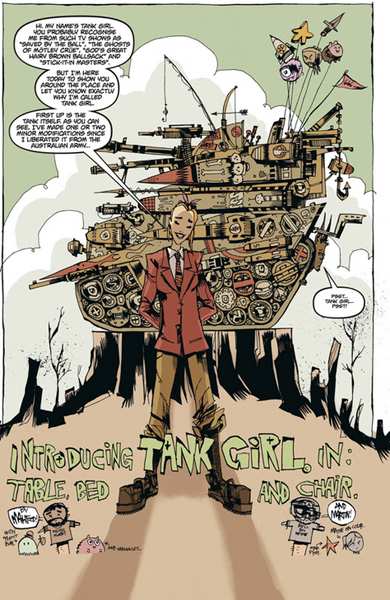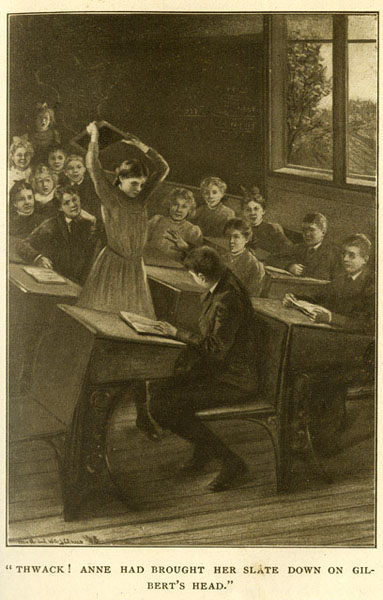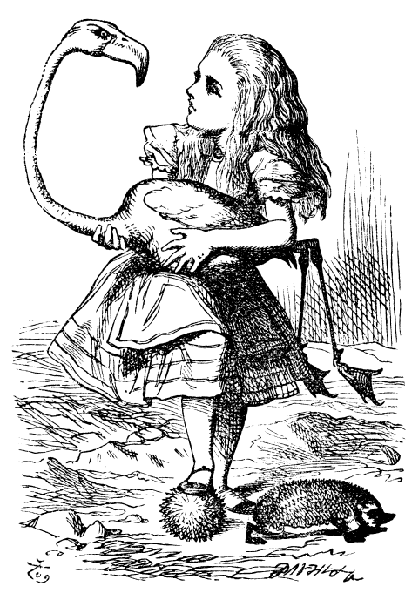
“I’m not bad. I’m just drawn that way.”
Jessica Rabbit, from Who Framed Roger Rabbit? (1988)
 While this exhibition is not about animated girls, Ms. Rabbit’s disclaimer about her appearance versus her behavior/character is entirely appropriate. We are looking at illustrations—drawings or sketches executed in ink, pencil, charcoal, chalk or woodcut, as well as contemporary digital media—of girls, real and fictional to see what they reveal.
While this exhibition is not about animated girls, Ms. Rabbit’s disclaimer about her appearance versus her behavior/character is entirely appropriate. We are looking at illustrations—drawings or sketches executed in ink, pencil, charcoal, chalk or woodcut, as well as contemporary digital media—of girls, real and fictional to see what they reveal.
This exhibition takes a broad look at girls drawn from the past. We are considering all relevant cultures (meaning those that produced this type of work) and types of book or print from the Gothic (~800-1300) to the Contemporary. Our goals are to investigate the visual language of representing girls/girlhood, their contexts and possible meanings in print over the last 1200 years.
Source material for these images range from early religious texts to contemporary comic books. These are sites of simultaneous character creation and manipulation, where words perhaps have described a person that is corrupted through the image making and distorts the intention of the author, which of course can be bad or good. Some books with lackluster stories or characters have been saved by their illustrations. And ultimately it is the reader’s decision to adopt the visual provided as their image of the character or not.
The exhibition examines 26 images chronologically, from around the world. These images are representative of different types of print media (excluding advertising). While this exhibition is not in any way comprehensive of all drawn representations of girls/girlhood throughout time, it will provide interesting insights and a good basis for further research.
As a new addition to this exhibition, we wanted shout out to new girl illustrators. Our first is Emmalene Oysti. Emmalene is a Fine Artist and Illustrator from Marquette, Michigan and recently received her Bachelor’s of Fine Arts degree in Art & Design from Northern Michigan University. Her work often utilizes layers of mixed media to create a variety of textures, vibrant colors, and qualities of realism.
Feminine Characters, Books, & Readers, takes inspiration from Jane Austen’s Pride & Prejudice, in which she writes, “I declare after all there is no enjoyment like reading!” and represents influential female figures in literature.
Interview with Illustrator Grace Lee
 Email interview with Grace Lee, Illustrator of Amazing Babes
Email interview with Grace Lee, Illustrator of Amazing Babes
How did you get involved with the wonderful book, Amazing Babes?
Eliza Sarlos, the writer of Amazing Babes, is a long time friend of mine from back in University days. She approached me to do the illustrations for a book she wanted to write for her first son, Arthur. That book was the start of Amazing Babes. Initially, she had only intended for the book to be for her son, and it took A LOT of effort on her part to convince me to do it. Not because of the content–I LOVED the idea–but mainly because I hadn’t drawn people before and I didn’t feel confident that I’d be able to do the project justice.
Did you have a particular inspiration for these illustrations?
One of my main concerns about drawing people was that my drawings generally don’t look realistic. I usually draw inanimate objects for work, so while a bottle or a box can look sort of cute if not drawn to scale or as in real life, I felt that people needed to be at least be recognisable. Again, Eliza came to the rescue. She reminded me of Maira Kalman’s incredible work and how it is possible to draw something with a likeness, and that that likeness can convey a lot of the qualities of a person, even if it doesn’t look exactly like them.
Who were your girlhood heroines?
To be honest, I didn’t really have an idea of heroines or heroes until I got a little older. I grew up trying to rebel against my parents’ old school thinking that there were ‘girl’ jobs and ‘boy’ jobs. It’s the way they were brought up, and whilst their attitudes have changed over time, I’m glad that I didn’t accept that line of thinking as a young girl. I think I really resented cleaning the bathroom! I guess my role-models were my teachers and my older sisters. They did a good job of making me feel like I could do anything but also reinforcing that there aren’t ‘girl’ jobs and ‘boy’ jobs. In my late teens, the Spice Girls became hugely popular, and yes it’s a bit cringe-worthy to admit, but I loved them and I loved the idea of girl power and being yourself. Thinking back now, my mum is one of my heroines. She moved to Australia with next to no English, and (along with my dad) raised six kids. I remember when I was thinking about deferring university for the second time, she put her foot down and told me to finish my degree. it broke my heart when she said, “you don’t want to be like me, don’t rely on a man, stand on your own two feet.” She was referring to not having a degree–she wanted me to have as many options and opportunities that I could have. I realised then, that I did want to be like her. Even if she hasn’t done anything that’s changed the world on a grand scale, but she’s been a huge influence in my world.
As an illustrator, what is your approach to drawing girls?
I don’t have a different approach for girls or boys. We’re all just humans, so my approach when drawing people is to try to capture the essence of that person, a general likeness and as many details as I can. I try my best to illustrate the person as I see them, as opposed to drawing a caricature.
What do you think about girls drawn grossly out of proportion, emphasizing sexual characteristics? Is there an appropriate place for these images?
I really think it depends on the context, the intention behind the work, and if it is used to spark debate or conversation. Art is so subjective and with all forms of art, not everyone will like it. There are a wealth of images out there, so I think it’s important to keep putting out more materials, resources and places for inspiration for girls to help them create their own image of a strong female.
Is becoming/being a girl illustrator difficult?
For example, are there still challenges to training, being accepted/taken seriously/winning jobs over boy illustrators… I sometimes forget how lucky I am to be living in a time where being female isn’t an issue in my line of work, I know this is not the same for all industries or in other parts of the world, so I feel incredibly privileged and grateful to have had many opportunities. I think illustration is an area where the artist is known more so for their work than for their name. I’ve personally not had any issues with competing with males, nor have I heard about any from with my colleagues. The illustration agency I’m with in Tokyo has (I’m pretty sure) more girls on the roster than boys! It’s definitely important to encourage girls (and boys) to follow their dreams and to help them know that the opportunities are there, obstacles and all!
Why are girl illustrators important?
I think it’s really important for everyone to have the opportunity to do the things they want in life, regardless of what gender they are. I feel really lucky that I live in a time where it’s not a big deal for me to be an illustrator, I know there was a time when it would have been, so in that respect I think it’s important that there are girl illustrators in the same way I think it’s important that there are girl doctors, lawyers, firefighters and teachers–everyone has different strengths and different talents and its great we live at a time when we can follow those talents and achieve incredible things in whatever field we choose.
Who is your favourite illustrated girl?
From Amazing Babes? My favourite women to draw were Leymah Gbowee and Irena Sendler. I loved drawing Leymah because I was listening to her TED talk at the time and just really fell in love with how articulate, confident and intelligent she is. She’s an incredible woman and more inspiring that I could describe. I also loved drawing Irena Sendler because I started to draw her as a young lady, but then changed my mind and drew her older. I loved drawing the lines on her face, I thought they showed all the stories and the struggles and triumphs in her life.
Any comments you would like to make generally about this subject?
I loved being part of the Amazing Babes project. It was a chance for me to learn about lots of inspiring women, quite a few of whom, I hadn’t heard of before. It’s also something that my niece can read, as well as many other boys, girls and adults. Thank you for the opportunity to share my thoughts and for inviting me to be part of Illustrated Girls.
Alters
Alters is a comic first published in 2016, written by Paul Jenkins and illustrated by Leila Leiz. Set in modern day America, battles between good and evil are at an impasse. Additionally, Alters have begun appearing. No one knows if they are mutants or something else,...
Ada Twist, Scientist
Ada Marie Twist is named after two of the many influential (and often underappreciated) women of science whose curiosity led to incredible discoveries. The Marie comes from Marie Curie, whose discovery of the elements polonium and radium led to the invention of...
Ms. Marvel
Kamala Khan is the fictional superheroine in the Marvel Comics series, Ms. Marvel, which debuted in its current format in 2015. Khan, who is a Pakistani-American, is the first Muslim character to headline in her own comic book. She originally appeared in Issue #14 of...
The Name Jar
Yangsook Choi wrote and illustrated The Name Jar in 2001. It relays the story of Unhei, a young girl from Korea whose family moved to America. On her first day of school, Unhei's fellow classmates fail to pronounce her name. They continue to make fun of it, referring...
Persepolis
Persepolis is a graphic memoir written and illustrated by Marjane Satrapi. It is the story of Marjane's coming of age during and after the Iranian Revolution of 1978 and the Iran-Iraq war. The title comes from the name for a historic Iranian city which was once the...
The Turbulent Term of Tyke Tiler
Tyke Tiler is a fictional girl from Gene Kemp's 1977 novel, The Turbulent Term of Tyke Tiler. A daring and energetic twelve-year-old, Tyke is always at the centre of trouble. Fighting in class, stealing watches, and finding sheep skeletons are not unusual occurrences....
Roll of Thunder, Hear My Cry
Cassie Logan is the narrator and protagonist of Mildred Taylor's 1976 novel, Roll of Thunder, Here My Cry. Taylor creates a story that highlights racism, segregation and childhood in rural Mississippi in 1933, through the eyes of a nine-year-old African American girl,...
Island of the Blue Dolphins
Island of the Blue Dolphins is a 1960s children's book by Scott O'Dell, and it tells the story of a young girl who gets stranded for years on an island off the Californian coast. Juana Maria was a Native American who was left for 18 years on San Nicolas Island during...
The Adventures of Her Serene Limpness, the Moon-faced Princess, Dulcet and Debonaire
The Adventures of Her Serene Limpness, the Moon-faced Princess, Dulcet and Debonaire was written in 1888 by English author Frederica St. John Orlebar. The book tells the story of a young princess of Japan, the daughter of a Japanese prince and a shipwrecked...
Carly and Nan
Carly Keene: Literary Detective is a new character in the young adult literature world. She is a terrific role model for young girls as a twelve year old who loves adventure, reading, and trusts her own mind and intuition in a refreshing way.
Malala
Malala is familiar in her head scarf and her big brown eyes draw us in to remind viewers of what she has seen and been through.
Hit Girl
Hit-Girl, as a spin-off of Kick-Ass, aims to draw in the same audience, but by having a female main character, it has the potential to attract additional female readers as well.
Tank Girl
Tank Girl, created by Jamie Hewlett and Alan Martin, is an extreme character who challenges previously established notions of femininity.
Peppermint Patty
Like the rest of the Peanuts’ gang girls, Peppermint Patty is pretty forthright and speaks her mind. She doesn’t let anyone get away with unkindness, but she isn’t the brightest nor that intuitive. She often misunderstands social situations and has a tendency to appreciate her own version of reality over others.
Supergirl
DC Comics wanted to know how the public felt about a completely new counterpart for Superman, and because of the positive response, Supergirl was introduced to the world in 1959.
Pippi Longstocking
Pippi Longstocking, whose amazing full name is Pippilotta Delicatessa Windowshade Mackrelmint Ephraim's Daughter Longstocking, is a one-of-a-kind girl from a series of Swedish books written by Astrid Lindgren in the 1940s. The Pippi stories were written for Lindgren's...
Fern Feeding Wilbur
Fern is the main human character, a staunch 8-year-old who saves a baby pig in order for the rest of the novel to unfold. After she looks after him, he is transferred to a farm down the road, and saving his life becomes a task of a smart spider named Charlotte, for whom the book is named.
Madeline
Madeline is the title character from a series of five books by Austrian author Ludwig Bemelmans. First published in 1939, the last of the series came out in the early 1960s. Intended for a broad audience, the stories would have had a specific draw for girls.
Little Lulu
Lulu Moffat was created by illustrator Marjorie Hendersen Buell. From the start Lulu was clearly a headstrong little girl.
Ingalls’ girls
The Little House on the Prairie books were written by Laura Ingalls Wilder and published from 1932-1943. They were based on her childhood, growing up in late 19th century Midwest America
Anne of Green Gables
While Anne was invented, her situation was based on a real story from Montgomery’s hometown and her appearance was lifted from a photograph of Evelyn Nesbit…
Little Red Riding Hood
Little Red Riding Hood is a story we all like to think of as familiar and pretty straightforward. However, the original is not so pleasant and actually would give most children‚ and many adults‚ nightmares.
Cosette
Little Cosette with her oversized broom is possibly one of the most recognized illustrations of a girl today. Her face evokes tears from those familiar with the Les Miserables musical
Alice
She is based on a real girl, Alice Liddell, and her sisters. Carroll spent a great deal of time with these girls and their family, and was fond of telling them stories on their rowing trips.
Thumbelina
Thumbelina is a tiny girl, about the size of a thumb (surprise), created by Hans Christian Anderson in his fairy tale of the same name from 1835.
Ophelia
Ophelia is one of the main female characters in William Shakespeare’s tragic play Hamlet. Ophelia is the love interest of Prince Hamlet, and the daughter of Polonious and sister of Laertes. Ophelia is cruelly spurned by Hamlet, and then driven to madness when Hamlet accidentally kills her father.
Activity Guide
Credits
The Girl Museum Team for this show was Katie Weidmann, Rachel Witte, Emily Holm, Julie Anne Young, Hillary Hanel and Casey Grymek. We do not assert any ownership of any of the images in the exhibition, they are Fair Use for Educational purposes.
If you have a question or issue with the use of any of these image on this site, please let us know.



























